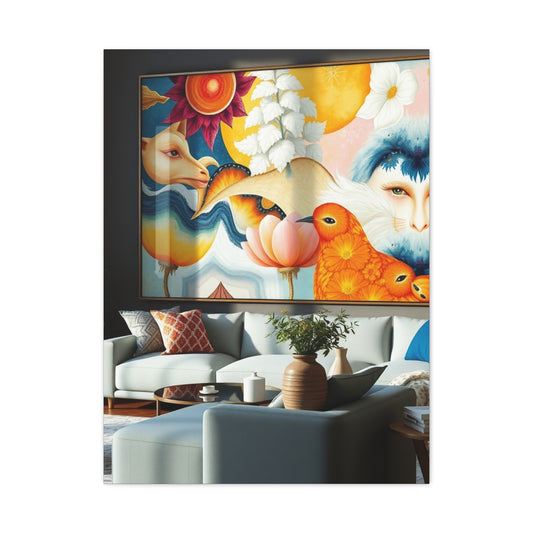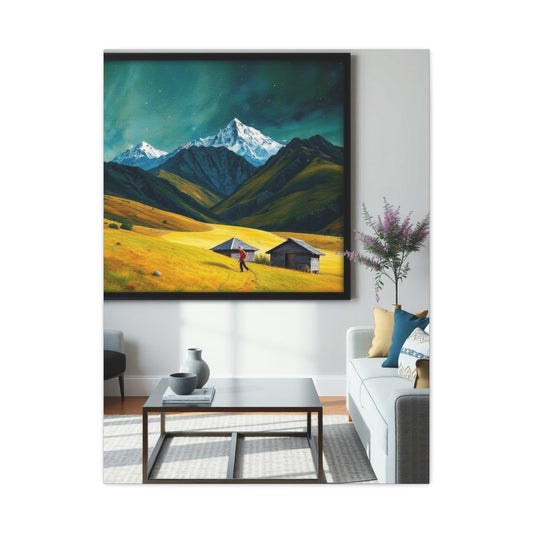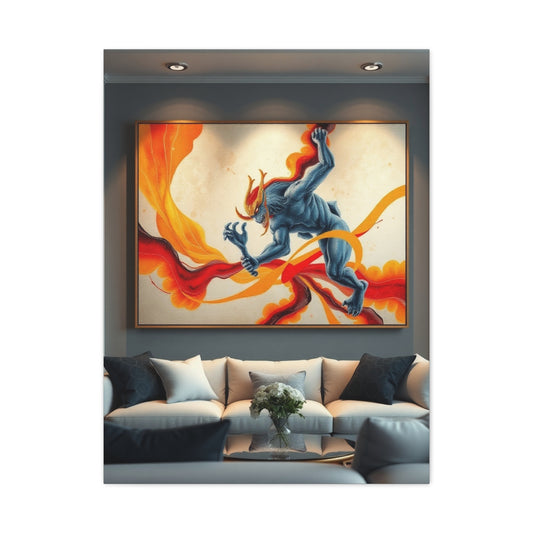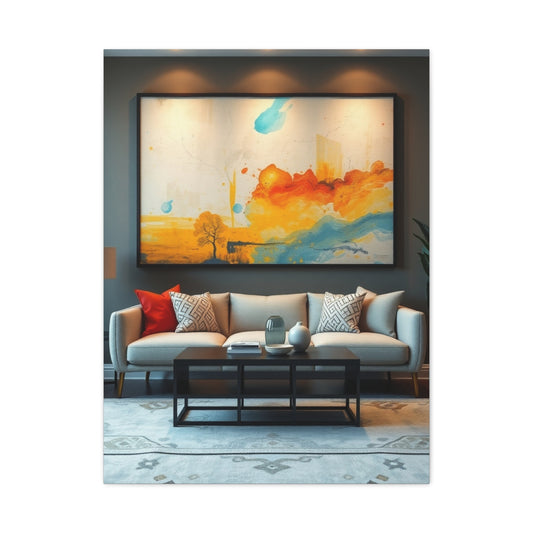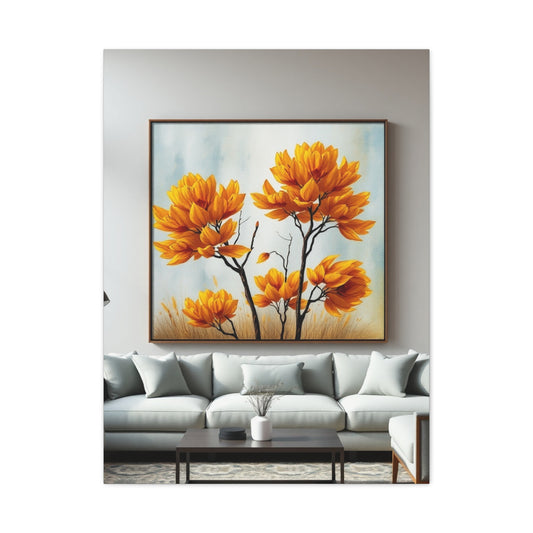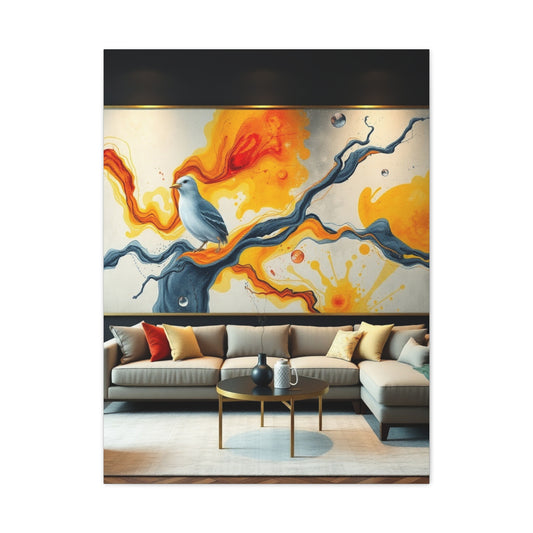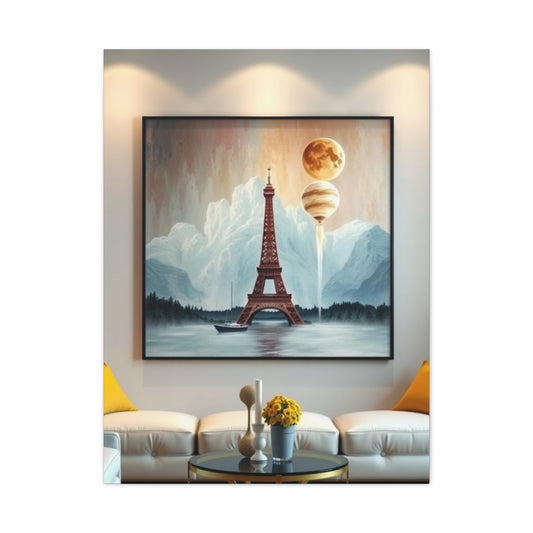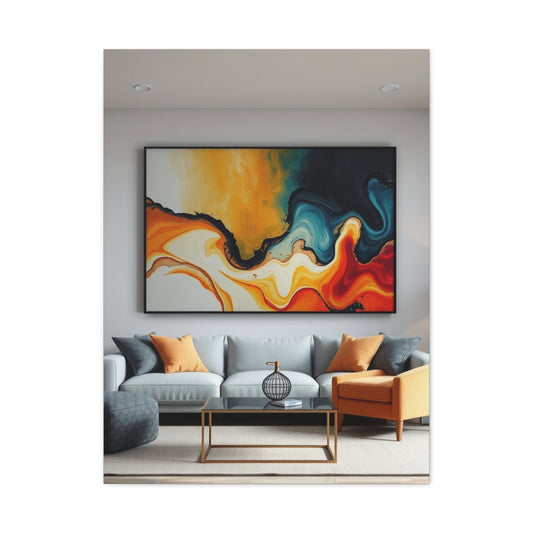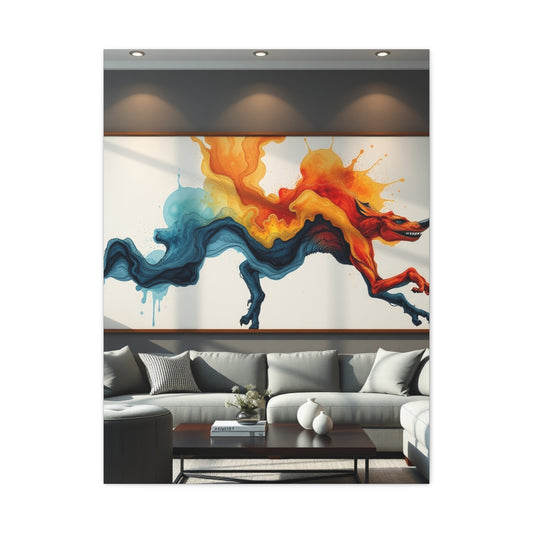Large Living Room Wall Art: Bold Choices for a Stylish Space
As we move into 2024, living room wall art is transforming in ways that reflect shifting lifestyles, emerging technologies, and evolving cultural values. This new era of interior design emphasizes not only aesthetics but also sustainability, personalization, and immersive experiences. Wall art is no longer merely decorative; it has become an active participant in how people perceive and interact with their living spaces. From eco-conscious creations fashioned from recycled materials to avant-garde digital canvases, the trends reshaping modern interiors are more dynamic and inclusive than ever before.
Art for the living room is uniquely positioned at the intersection of personal expression and shared experience. Unlike other rooms in the home, the living room serves as both a private retreat and a social hub, where design choices make a profound impact on atmosphere, identity, and even well-being. The wall art trends that are flourishing this year highlight themes of sustainability, technology, cultural storytelling, and minimalist refinement, offering an expansive palette of options for homeowners and designers alike.
This exploration delves into the ten most influential trends dominating living room decor in 2024. By understanding their historical origins, foundational ideas, diverse categories, and practical applications, you can discover how wall art is redefining the modern home and how these creations resonate with broader societal shifts.
Historical Background
The story of wall art in living spaces is centuries old, tracing back to prehistoric cave drawings that marked early attempts to translate experience into visual form. Over time, civilizations infused their dwellings with wall adornments that reflected cultural beliefs, social hierarchies, and evolving artistic sensibilities. In the Renaissance, frescoes and tapestries adorned the walls of palaces, symbolizing wealth and intellectual refinement. During the industrial age, mass-produced prints democratized art, making it more accessible to middle-class households.
The 20th century introduced seismic shifts in art styles that redefined wall decor. Abstract expressionism brought bold brushstrokes and emotional depth into domestic interiors, while minimalism stripped walls to their essentials, emphasizing negative space and calm clarity. By the late 20th century, photography and poster culture proliferated, offering inexpensive ways for people to showcase identity and taste.
Entering the digital age, technological innovations began to transform how people engaged with art. Projection, augmented reality, and digital frames offered new ways of curating and experiencing visuals. In parallel, environmental consciousness reshaped the way art was produced, as artists began experimenting with reclaimed, biodegradable, or renewable materials. This layered history forms the foundation for the current trends shaping living room walls in 2024.
Core Concepts and Foundations
The present trends in living room wall art are not random fluctuations; they emerge from interconnected concepts deeply rooted in broader societal developments. Three main foundations underpin this evolution:
Sustainability as Aesthetic and Ethos
The growing urgency of climate change has spurred artists and homeowners to reconsider how decor is produced and consumed. Sustainable art, whether through recycled materials or ecological themes, not only reduces waste but also conveys ethical alignment. Wall art becomes both a statement of values and a beautiful narrative piece.
Technology as an Artistic Medium
The fusion of art and technology expands the possibilities of what wall decor can achieve. From augmented reality layers to dynamic LED installations, technology transforms static pieces into living, interactive experiences. These innovations align with a generation that values adaptability, customization, and immersive environments.
Emotional and Cultural Resonance
In an era where identity and heritage are increasingly celebrated, wall art serves as a vessel for storytelling. Cultural motifs, heritage-inspired pieces, and artworks with emotional symbolism bring depth to interiors. Whether minimalist line drawings or expressive oversized canvases, the underlying goal is to establish a connection between art, space, and human experience.
Sustainable and Eco-Friendly Art for Living Room Wall
One of the most prominent movements in 2024 centers around eco-consciousness. This category includes two distinct manifestations.
Art from Recycled Materials
Discarded wood, reclaimed metal, and repurposed plastics are transformed into exquisite compositions that embody both creativity and environmental responsibility. Each piece carries a narrative—be it a sculpture welded from industrial remnants or a mosaic crafted from shattered ceramics. These works not only reduce ecological footprints but also enrich living spaces with texture, story, and authenticity.
Environmental-Themed Artwork
Beyond materials, the themes themselves underscore ecological awareness. Paintings of fragile ecosystems, abstract depictions of rising seas, or poignant portraits of endangered animals provoke thought while enhancing decor. By blending aesthetics with advocacy, these pieces act as subtle reminders of humanity’s interconnectedness with nature.
Interactive and Tech-Integrated Living Room Wall Art Decor
Technology-driven art is no longer a futuristic novelty but an everyday reality.
Digital Frames
Digital canvases allow homeowners to swap artworks at will, creating a versatile gallery that evolves with moods, seasons, or special occasions. With high-resolution displays, remote curation, and even subscription-based art services, these frames democratize access to masterpieces and personal photos alike.
Augmented Reality Enhancements
AR introduces dynamic storytelling into wall art. By pointing a phone at a canvas, viewers may unlock hidden animations, narrative overlays, or immersive soundscapes. This innovation shifts art from passive decoration into an experiential event, aligning perfectly with contemporary desires for engagement and interactivity.
Oversized Abstract Expressionism Large Pictures for Living Room
Grand-scale abstract expressionism continues its dominance in modern interiors.
Monumental Canvases
Expansive artworks with sweeping gestures and vibrant pigments become the undeniable focal points of living rooms. Their commanding presence elevates interiors, adding emotional resonance and dynamism.
Expressive Colors and Brushwork
Gestural brushstrokes, bold chromatic schemes, and intuitive compositions infuse living spaces with vitality. Beyond mere decoration, these works embody raw human emotion, echoing the freedom and improvisation of mid-20th-century masters while resonating with contemporary audiences.
Textured 3D Wall Art Pieces for Living Room
Flat surfaces give way to tactile, sculptural experiences.
Mixed Media Assemblages
Artists combine glass, fabric, wood, and metal to create rich, multi-layered artworks that invite touch and prolonged contemplation. These assemblages provide not just visual stimulation but also a sensory dialogue with the viewer.
Sculptural Art and Shadow Play
Strategically positioned three-dimensional works respond to natural and artificial light, shifting in appearance throughout the day. The resulting interplay of shadow and illumination transforms walls into living landscapes of subtle dynamism.
Biophilic Design Elements & Family Room Wall Art
Biophilic art integrates organic forms and natural imagery into domestic interiors.
Living Walls and Moss Panels
These living installations bring literal greenery indoors, enhancing air quality and acoustic balance. Moss walls in particular offer low-maintenance natural beauty while imbuing living rooms with calming serenity.
Nature-Inspired Prints and Photography
From panoramic ocean vistas to intimate botanical close-ups, these works connect dwellers with the restorative power of the natural world. They act as portals to tranquil environments, counterbalancing urban stress.
Customized Neon Signs
Neon has resurfaced as a versatile art form, blending nostalgia with modernity.
Personal Phrases and Messages
Custom neon inscriptions allow individuals to immortalize personal mottos, humorous lines, or inspirational quotes in glowing hues. These pieces combine warmth with character, fostering intimacy and personality.
Abstract Neon Shapes
Geometric and freeform designs capture modern aesthetics, accentuating minimalist or eclectic interiors alike. Their luminous presence creates a playful yet sophisticated ambiance.
Gallery Living Room Art with a Twist
The gallery wall concept evolves into more experimental formats.
Asymmetrical Layouts
Rejecting rigid grids, asymmetrical arrangements encourage freedom, spontaneity, and visual rhythm. Such layouts often mix frame sizes, orientations, and materials, forming curated narratives that feel organic and personal.
Mixed Media Combinations
Pairing photography with paintings, illustrations, or sculptural objects produces layered compositions that blur categorical boundaries. These dynamic juxtapositions engage the eye with contrast, variety, and storytelling.
Minimalist Line Living Room Artwork
Minimalist approaches continue to thrive among those seeking calm and clarity.
Elegant Line Drawings
Simple strokes distill form and emotion into elemental expression. They offer sophistication without overwhelming interiors, lending balance and serenity to even the busiest spaces.
Monochromatic and Muted Palettes
Restrained chromatic schemes, whether black-and-white or earth-toned, adapt seamlessly to diverse design contexts. Their quietude allows other furnishings to shine, while maintaining timeless elegance.
Cultural and Heritage-Inspired Pictures for the Living Room
Diversity and identity emerge as defining values in modern art.
Global Narratives
Wall art reflecting cultural practices or personal heritage transforms decor into a meaningful testament to human history. Such pieces deepen appreciation of global artistry while honoring traditions.
Traditional Techniques in Contemporary Forms
Artisans reimagine ancient crafts, from weaving to pottery, adapting them to contemporary aesthetics. These fusions of old and new create works that are simultaneously familiar and fresh.
Lounge Wall Art & Light Installations
Light emerges as a primary medium, shaping atmosphere in transformative ways.
LED-Based Artwork
Color-shifting installations or interactive panels infuse futuristic vibrancy into living rooms. The adaptability of LEDs ensures that moods and tones can shift with a simple adjustment.
Projection Mapping
Walls metamorphose into dynamic canvases through projected visuals. This cutting-edge approach offers infinite variability without permanent installations, catering to individuals who crave continual reinvention.
Practical Applications
The ten emerging trends in wall art for 2024 can be applied across living spaces in ways that enhance both function and emotion.
-
Sustainable art pieces can become conversation starters, aligning personal values with aesthetic refinement.
-
Digital frames allow art lovers to curate constantly evolving collections, minimizing monotony.
-
Large abstract canvases provide bold focal points, anchoring open-plan spaces.
-
Textured 3D works create sensory richness, ideal for living rooms with abundant natural light.
-
Biophilic designs support wellness, particularly in urban settings where greenery is scarce.
-
Customized neon signs inject playfulness, character, and warmth into social spaces.
-
Asymmetrical gallery layouts enable personal storytelling, showcasing diverse aspects of identity.
-
Minimalist line drawings harmonize well with contemporary, uncluttered interiors.
-
Cultural and heritage-inspired pieces infuse depth, authenticity, and inclusivity.
-
Light installations transform the atmosphere, ensuring living rooms adapt to different moods and gatherings.
Through these applications, homeowners can curate living environments that are not only visually compelling but also emotionally resonant and environmentally responsible.
Techniques and Methods
The evolution of living room wall art in 2024 is not only about the themes and aesthetics but also about the technical processes artists and designers employ to bring their visions to life. These methods range from traditional craftsmanship to high-tech innovations, each shaping the way wall decor influences interiors.
Sustainable Creations through Repurposing
Sustainable wall art often relies on methods that transform discarded objects into new treasures. Artists working with reclaimed wood, for example, may sand, carve, and reassemble planks into striking panels or reliefs. Metalworkers weld together fragments of industrial scrap, forging sculptures that juxtapose ruggedness with elegance. Mosaicists collect shattered ceramics or glass and arrange them into colorful, symbolic compositions that highlight both beauty and imperfection. Such techniques not only minimize waste but also embed a sense of history into each piece, as every material carries the memory of its former use.
Digital Innovations in Wall Decor
On the technological side, advanced printing methods and high-resolution screens dominate the creation of digital frames and projection art. Giclée printing, known for its extraordinary color fidelity and archival quality, enables artists to reproduce digital artworks with depth and precision. Projection mapping employs specialized software to tailor images onto walls, adjusting for angles and surfaces, thereby creating immersive experiences that can change in real-time. Augmented reality applications rely on layering digital imagery onto physical works, requiring meticulous calibration of lighting, scale, and motion tracking to maintain believability.
Traditional Brushwork and Contemporary Abstractions
While new media continue to gain ground, painting remains an enduring technique. Abstract expressionism in particular demands a mastery of scale, rhythm, and spontaneity. Artists often use broad brushes, palette knives, or even unconventional tools like sponges or fabric to achieve textures and gestures that radiate intensity. Layering techniques such as glazing or impasto give depth to large-scale works, creating visual energy that commands attention in a living room setting.
Textural and Three-Dimensional Approaches
Creating textured or sculptural wall art involves methods that integrate different media into one cohesive piece. Assemblage techniques require precision in combining disparate materials while ensuring durability. Light-reactive surfaces such as mirrored glass or translucent resin demand an understanding of illumination, so the final piece interacts with its surroundings throughout the day. Fiber-based artworks like woven panels or macramé installations necessitate expertise in knotting, dyeing, and pattern creation, giving walls a tactile warmth that bridges craft and fine art.
Biophilic Art Practices
Living walls and moss installations call for specialized horticultural techniques. Designers must select plant varieties suited to indoor conditions, incorporate irrigation systems, and plan arrangements that balance visual harmony with ecological function. Preserved moss art requires careful treatment processes that maintain vibrancy without ongoing care, blending biology with artistry. Similarly, nature-inspired photography relies on techniques such as long-exposure captures, aerial imaging, and macro photography, offering perspectives that reconnect urban dwellers with organic environments.
While the popularity of wall art for the living room continues to rise, homeowners and designers often encounter pitfalls in their approach. Recognizing these challenges can help avoid missteps that diminish the impact of decor.
Overcrowding and Visual Clutter
One frequent mistake is the tendency to overload walls with too many competing elements. An excess of artwork can overwhelm the eye and disrupt the harmony of a room, leading to sensory fatigue rather than inspiration. Effective wall design requires a sense of proportion, rhythm, and breathing space, ensuring that each piece can be appreciated fully.
Poor Alignment with Room Aesthetics
Another challenge arises when wall art does not harmonize with the broader interior scheme. A neon sign might clash with a rustic, earth-toned room, or a heavily ornate painting may feel out of place in a minimalist setting. The key lies in balancing contrast with cohesion, selecting artworks that either complement or thoughtfully disrupt the design narrative without creating dissonance.
Misjudging Scale and Proportion
Large wall art pieces can anchor a room beautifully, but when chosen without regard for wall dimensions or furniture placement, they can dominate or diminish the space awkwardly. Similarly, overly small pieces may appear lost against expansive walls, failing to create the intended impact. Measuring dimensions, experimenting with mock layouts, and understanding sightlines are crucial steps in avoiding these mistakes.
Neglecting Lighting Considerations
Lighting plays a critical role in how wall art is perceived. Poorly lit artworks can appear flat, muted, or overlooked. Conversely, harsh or misplaced lighting can create glare that obscures details. Integrating spotlights, ambient illumination, or even natural light planning ensures artworks are seen in their best form, emphasizing depth, color, and texture.
Overuse of Trends without Personal Connection
Another common misstep is adopting wall art trends without considering personal resonance. While a moss wall or oversized abstract might be fashionable, if it lacks emotional connection to the homeowner, it risks becoming an impersonal design choice. Art gains power when it aligns with identity, memory, or aspiration, turning decoration into narrative.
Trends and Future Outlook
The trajectory of living room wall art points toward the continued fusion of artistry, technology, and ecological consciousness. Looking ahead, several emerging tendencies are poised to shape interiors beyond 2024.
Increasing Integration of Smart Technology
Smart homes will influence the evolution of wall decor. Digital frames are likely to become more sophisticated, incorporating motion sensors, AI-driven curation, or integration with voice assistants. Projection mapping may become standard in luxury living rooms, offering walls that shift with mood, music, or time of day. Interactive AR installations could become commonplace, blurring the line between art, entertainment, and education.
Expansion of Sustainable Practices
As ecological awareness deepens, more artists will embrace biodegradable materials, natural dyes, and carbon-neutral production processes. Artworks may evolve to serve dual functions, such as panels that purify air, absorb sound, or regulate humidity while remaining visually striking. The fusion of art and environmental engineering is expected to grow into a distinct design discipline.
Rise of Culturally Hybrid Art Forms
Globalization continues to enrich art, inspiring cross-cultural hybridization. Living room walls may feature pieces that combine motifs from multiple traditions, creating new visual languages that embody interconnectedness. Digital tools allow artisans from different continents to collaborate, weaving together influences from indigenous crafts, contemporary design, and global narratives.
Demand for Personalization and Storytelling
In an era of individuality, bespoke artworks will dominate. Whether through customized neon inscriptions, commissioned portraits, or curated gallery arrangements, homeowners will increasingly favor art that mirrors personal journeys. Technology will accelerate this demand by enabling platforms where users co-create works with artists in real time.
Minimalism Evolving toward Emotional Depth
While minimalist line drawings remain popular, the future outlook points toward minimalism enriched with symbolic resonance. Subtle forms may convey deeper stories, integrating poetry, cultural motifs, or layered meanings within deceptively simple compositions. This evolution balances clarity with complexity, ensuring minimalism continues to thrive without monotony.
Expert Insights
The perspectives of artists, designers, and cultural theorists provide a deeper understanding of why wall art trends matter and how they influence human environments.
Artists on Materiality
Contemporary artists often emphasize that materials themselves carry narratives. Working with reclaimed wood or rusted metal is not just an ecological choice but a storytelling device, embedding history into new creations. According to many creators, texture, imperfection, and irregularity invite deeper engagement, reminding viewers of the passage of time and the resilience of transformation.
Designers on Atmosphere
Interior designers frequently highlight the role of wall art in shaping ambiance. A large abstract canvas can electrify a neutral room, while a minimalist drawing can calm a visually busy environment. For designers, art is not merely decorative but atmospheric, influencing how people feel and behave within a space.
Cultural Commentators on Identity
Cultural theorists argue that the rise of heritage-inspired art reflects broader societal shifts toward inclusivity and self-expression. By integrating traditional motifs into modern homes, individuals reclaim narratives that may have been marginalized or forgotten. Wall art thus becomes an arena for cultural affirmation, allowing personal and collective identities to coexist within domestic spaces.
Technologists on Innovation
Experts in digital art foresee exponential growth in interactive wall decor. As hardware becomes more affordable and software more intuitive, immersive installations will migrate from galleries into homes. They predict that within a decade, many living rooms will host dynamic, programmable walls capable of transforming at will, merging cinematic experience with domestic intimacy.
Environmentalists on Sustainable Art
Environmental advocates stress that sustainable art does more than beautify—it cultivates awareness and responsibility. By incorporating recycled materials or ecological imagery, wall art becomes a subtle but persistent reminder of planetary interdependence. For them, sustainable wall decor is not a fad but a moral imperative that harmonizes aesthetics with ethics.
Techniques, challenges, trends, and expert insights reveal that wall art for the living room in 2024 is as much about meaning as it is about beauty. The technical mastery behind these creations—whether digital, traditional, or sustainable—underscores the artistry involved in shaping interiors that reflect modern values. Avoiding common mistakes ensures that artworks enhance rather than overwhelm spaces. The outlook promises exciting developments, with technology, sustainability, and cultural diversity leading the way. Expert voices remind us that at its core, wall art is a dialogue between space, individual, and society—a dialogue that continues to evolve in fascinating ways.
Emerging Trends in Wall Art
The trajectory of wall art in 2024 and beyond highlights how design, technology, and cultural sensibilities continue to intertwine. As living rooms become more than functional spaces and transform into arenas of personal storytelling, the trends surfacing are not fleeting fashions but reflections of deeper cultural currents.
Immersive Digital Experiences
One of the most transformative trends involves the fusion of art with immersive technology. Digital frames are now more sophisticated than simple photo slideshows. They integrate with cloud-based services, enabling collectors to subscribe to rotating exhibitions curated by global institutions. Projection mapping brings walls to life with shifting patterns, landscapes, or cinematic scenes, allowing a single space to embody multiple moods. Augmented reality layers enable a single painting to reveal an interactive narrative when viewed through a smartphone, merging physicality with digital storytelling.
Biophilic Inspirations
Biophilic art remains deeply influential as more individuals seek refuge from urban overstimulation. Moss panels, living walls, and botanical prints align with psychological research that demonstrates the restorative power of nature imagery. These artworks not only enhance beauty but also serve functional purposes, such as improving acoustics or purifying air. The enduring popularity of biophilia in art reflects humanity’s innate need for connection with the natural world.
Monumental Abstract Works
Large-scale abstract expressionist canvases continue to dominate interiors, providing both drama and meditative depth. The contemporary adaptation of this style often involves unusual materials—such as metallic pigments, fabric inserts, or reflective surfaces—adding new dimensions to traditional gestural brushwork. Such artworks often serve as conversation anchors within social gatherings, radiating dynamism and individuality.
Cultural Storytelling
A prominent emerging theme is the rise of cultural and heritage-inspired art. Homeowners increasingly gravitate toward artworks that reflect their ancestry, identity, or global appreciation. From indigenous patterns reimagined in modern contexts to hybrid forms that blend traditional motifs with digital artistry, cultural narratives embedded in wall art enrich living spaces with authenticity and significance.
Sustainable Aesthetics
The demand for eco-conscious wall art remains strong. Recycled metal sculptures, reclaimed wooden panels, and artworks crafted from biodegradable textiles are not only visually compelling but also resonate with ecological ethics. The marriage of sustainability with aesthetics demonstrates that environmental responsibility can harmonize seamlessly with refined taste.
Illuminated Installations
The incorporation of light as an artistic medium has expanded significantly. LED-based wall panels, neon sculptures, and interactive light art redefine how people engage with interiors. These installations can shift hues according to mood, respond to sound, or change based on natural circadian rhythms, merging functionality with spectacle.
Step-by-Step Guides
To bring these trends into practice, clear approaches are essential. While artistic creation is deeply personal, following structured guidance ensures balance, functionality, and resonance. Below are detailed step-by-step guides for incorporating different wall art approaches into living room spaces.
Guide to Selecting Sustainable Wall Art
Step 1: Assess Your Values and Intentions
Before selecting eco-conscious pieces, clarify your priorities. Are you seeking art that uses recycled materials, or do you want works that highlight environmental themes? Establishing intention ensures your choices resonate beyond surface appeal.
Step 2: Research Artists Specializing in Sustainability
Look for creators whose portfolios emphasize reclaimed or biodegradable materials. Many contemporary artisans publicize their ecological commitments, from sourcing discarded textiles to reusing industrial remnants.
Step 3: Evaluate Material Authenticity
When purchasing, confirm the authenticity of sustainable claims. Genuine eco-friendly art often details the origins of materials. Understanding whether wood is salvaged or whether dyes are natural ensures that your selection aligns with ecological ethics.
Step 4: Integrate with Living Room Aesthetics
Ensure that the chosen sustainable piece aligns with the broader decor. A reclaimed metal sculpture, for instance, can enhance industrial interiors, while a mosaic of recycled glass may harmonize with eclectic or bohemian themes.
Step 5: Position for Visual Impact
Sustainable pieces often carry intricate textures and subtle irregularities. Place them where light can accentuate their tactile qualities, allowing the narrative embedded in the materials to reveal itself fully.
Guide to Incorporating Digital Frames and AR Art
Step 1: Identify Desired Functionality
Digital frames range from basic image displays to advanced models with cloud connectivity, subscription services, and motion sensors. Decide whether you want a simple rotating gallery or an interactive art hub.
Step 2: Choose Resolution and Size Carefully
High-resolution screens preserve the richness of digital artworks. Select dimensions proportional to your living room wall so the frame neither overwhelms nor disappears within the space.
Step 3: Curate a Collection
Upload personal photography, acquire digital artworks, or subscribe to curated platforms. A balanced mix ensures variety while keeping the display personalized.
Step 4: Explore Augmented Reality Layers
If opting for AR-enhanced works, test them using mobile applications. Ensure the virtual overlays function seamlessly with the physical piece and consider how lighting or room layout influences the experience.
Step 5: Update Regularly
The strength of digital and AR art lies in dynamism. Refresh the content periodically to maintain novelty and align the wall’s atmosphere with seasons or moods.
Guide to Installing Oversized Abstract Expressionism
Step 1: Measure Wall Proportions
Oversized works thrive when they are scaled correctly. Measure both the wall and the surrounding furniture to avoid visual imbalance.
Step 2: Consider Color Palette
Select a piece whose palette either harmonizes with or strategically contrasts the room. Bright reds or electric blues can energize neutral rooms, while muted tones can soften bold interiors.
Step 3: Prepare for Hanging
Large canvases require sturdy mounting systems. Reinforce walls if necessary and ensure the weight is distributed evenly to prevent long-term damage.
Step 4: Enhance with Lighting
Use directed spotlights or ambient glow to amplify the brushwork and texture. Proper lighting brings depth to gestural strokes and ensures the painting commands presence.
Step 5: Balance Surroundings
Keep the surrounding decor minimal so the artwork remains the focal point. Oversized abstracts thrive when they dominate visually without competing distractions.
Guide to Designing a Gallery Wall
Step 1: Gather Diverse Works
Collect a mix of photography, paintings, and sculptural elements. Diversity creates dynamism and allows personal storytelling through variety.
Step 2: Plan Layout on the Floor
Before committing to wall placement, arrange artworks on the floor. Experiment with asymmetry, varying frame sizes, and orientations until a narrative emerges.
Step 3: Establish a Visual Anchor
Select one or two central pieces as anchors around which the rest of the gallery revolves. Anchors help maintain cohesion even in eclectic arrangements.
Step 4: Install with Precision
Use measuring tools to maintain spacing consistency, even in asymmetrical designs. Uneven placement may appear careless rather than curated.
Step 5: Refresh Over Time
Gallery walls thrive when they evolve. Replace or rotate pieces seasonally or as personal tastes shift, ensuring the display remains alive and reflective of current identity.
Guide to Creating Biophilic Living Walls
Step 1: Assess Room Conditions
Identify levels of natural light, humidity, and ventilation. This assessment determines which plants or moss types are viable.
Step 2: Select Plant Varieties
Choose species that thrive indoors, such as ferns, pothos, or air plants. For maintenance-free options, select preserved moss or dried botanical elements.
Step 3: Install a Support Structure
Use modular panels or specialized frames that hold soil, water, or moss securely. Incorporate irrigation systems if using live plants.
Step 4: Position Strategically
Place living walls where they can act as focal points without obstructing airflow or daily movement.
Step 5: Maintain Regularly
Water, trim, or rotate as needed. Preserved moss requires no care but should be kept away from direct sunlight to avoid fading.
Guide to Integrating Neon and Light Installations
Step 1: Define Purpose
Decide whether you want neon for personalized messages or abstract shapes. Purpose shapes design, size, and color.
Step 2: Select Appropriate Colors
Neon hues should complement room tones. Warm yellows create coziness, while blues or purples evoke futuristic energy.
Step 3: Mount Securely
Ensure neon tubes or LED panels are safely mounted with proper wiring. Safety is paramount, especially for homes with children.
Step 4: Control Illumination
Add dimmer switches or smart integrations to adjust brightness according to mood and occasion.
Step 5: Harmonize with Other Art
Use neon alongside minimalist works or gallery walls to create layered compositions. The glow can enhance adjacent textures, frames, or canvases.
The emerging trends in wall art reveal how design continues to evolve alongside technology, cultural exploration, and ecological responsibility. From immersive digital experiences to timeless abstraction, from biophilic inspiration to illuminated installations, these movements reflect the layered complexity of contemporary living. The step-by-step guides demonstrate how homeowners can actively participate in this evolution, ensuring that wall art becomes not just an accessory but a central narrative element of interior life. By applying careful planning, proportion, and authenticity, anyone can transform living rooms into spaces that embody both individuality and collective cultural momentum.
Expert Insights and Final Perspectives on Wall Art
The study of wall art within contemporary interiors is not just about design but about cultural resonance, emotional engagement, and personal expression. As interiors become canvases of identity, the role of experts—artists, curators, interior designers, and cultural commentators—gains greater weight. Their perspectives shape how wall art is perceived, selected, and integrated into domestic and public realms. Part four explores expert insights, synthesizes the practical lessons from earlier sections, and delivers a conclusion that underscores the living essence of art on walls.
The Evolving Role of Artists
Modern artists no longer confine themselves to traditional brushwork or canvas. Many expand into mixed media, digital projections, and sculptural elements. Conversations with practicing painters reveal that audiences today demand narratives, not just visuals. Artists often design pieces that encourage dialogue, whether through coded symbolism, interactive technology, or cultural motifs. The insight here is clear: wall art is moving from static decoration to active storytelling.
Curatorial Guidance for Homeowners
Curators emphasize the importance of intentionality when selecting art for living spaces. According to experts, one of the most common mistakes lies in prioritizing trendiness over authenticity. A work chosen merely to mimic current fashion often fails to maintain emotional longevity. Instead, curators advise developing a thematic vision for the home, whether rooted in memory, aspiration, or aesthetic preference, and then curating pieces that serve that vision.
Interior Designers on Placement
Interior designers frequently stress that placement can make or break wall art. Even an exquisite masterpiece risks invisibility if poorly positioned. Their advice typically revolves around symmetry, proportion, and environmental factors such as light and wall color. Designers also highlight negative space—understanding how blankness interacts with artwork ensures balance. For them, art is not an afterthought but a cornerstone of spatial orchestration.
Cultural Critics on Meaning
Critics remind us that art within homes participates in wider cultural dialogues. Displaying indigenous motifs, for example, carries responsibility. Experts argue for respectful engagement, which means understanding the history behind patterns, symbols, and narratives. They urge homeowners to explore provenance and context, ensuring that their walls do not merely exhibit aesthetics but also honor cultural origins.
Advanced Techniques for Incorporating Wall Art
Experts frequently share methods that transcend basic hanging or purchasing strategies. These techniques reflect years of experience and deeper awareness of how wall art interacts with human psychology and space.
Layering and Depth Creation
Rather than treating the wall as a flat surface, advanced designers advocate for layered compositions. This involves mixing paintings, sculptural reliefs, mirrors, and lighting elements to create dimensionality. The interplay of shadows, reflections, and textures generates a dynamic wall surface that evolves throughout the day.
Seasonal Rotations
Collectors are encouraged to rotate artworks seasonally. Beyond preventing visual fatigue, seasonal rotation aligns the atmosphere of the home with external rhythms. In winter, darker tonal works may create intimacy, while spring invites vibrant and floral pieces. Experts consider rotation not only practical but almost ritualistic, bringing renewal to interiors.
Integrating Art with Architecture
When art is conceived in tandem with architectural features, it achieves seamless integration. Niches, alcoves, and structural columns become natural frames for works. Some designers commission site-specific installations that respond directly to a room’s geometry, ensuring that the artwork does not simply hang on the wall but is woven into the architecture itself.
Lighting as a Sculptural Tool
Specialists emphasize that lighting is not merely functional but an artistic medium. Track lighting, spotlights, or LED panels can sculpt perception. Shadows can highlight texture, while the warmth or coolness of light influences mood. Expert lighting design ensures that the narrative of the wall art remains alive under shifting conditions.
Common Challenges and Expert Advice
While the rewards of integrating wall art are immense, challenges frequently surface. Experts identify common pitfalls and provide strategies to overcome them.
Misjudging Scale
A painting too small for a large wall can seem insignificant, while an oversized canvas on a narrow wall feels oppressive. Professionals recommend mapping proportions before purchase. Some even use mockups—projecting the artwork digitally on the wall to preview its presence before investing.
Overcrowding Walls
Many homeowners attempt to display too many pieces simultaneously, creating visual clutter. Experts suggest restraint, allowing negative space to breathe alongside artworks. A single powerful piece can often communicate more than a crowded gallery.
Ignoring Lighting Conditions
Even well-selected works lose vitality under poor lighting. Harsh glare may flatten details, while dimness can obscure nuance. Specialists emphasize the necessity of layered lighting solutions that adapt to day and night cycles.
Neglecting Personal Connection
Perhaps the most profound mistake is choosing art that lacks personal resonance. Experts underline that the best collections emerge when homeowners trust their instinct. Even if unconventional, a piece that stirs memory or provokes curiosity will retain significance long after trends shift.
Future Outlook: Where Wall Art is Heading
As we move further into the twenty-first century, the trajectory of wall art reveals exciting possibilities. Experts forecast that the future will be shaped by hybrid forms, greater accessibility, and heightened interactivity.
Expansion of Digital Collectibles
With the rise of blockchain technologies, digital art will continue to expand into domestic interiors. Non-fungible tokens, once restricted to screens, are increasingly displayed through advanced digital frames. This democratizes art ownership, allowing collectors to possess limited-edition works without geographic constraints.
Cross-Cultural Fusion
Globalization fuels a fascinating fusion of motifs and traditions. Artists draw inspiration from multiple heritages, resulting in hybrid artworks that defy singular classification. This trend, while promising innovation, also demands greater cultural sensitivity, as homeowners navigate authenticity and appropriation.
Sustainable and Ephemeral Art
Future wall art may lean toward ephemerality—installations designed to decompose or evolve. Artists are already experimenting with biodegradable substrates and pigments that shift hues depending on environmental conditions. This impermanence reflects a growing philosophical embrace of transience in design.
AI-Generated Creativity
Artificial intelligence is increasingly a collaborator in artistic production. Algorithms can generate abstract patterns, simulate brushwork, or even customize artworks in response to viewer preferences. Experts foresee AI-enhanced art becoming a staple of contemporary interiors, offering limitless variability.
Expert Recommendations for Collectors
Based on the collective wisdom of professionals, several guiding principles emerge for those seeking to cultivate meaningful wall art collections.
Invest in Storytelling
Choose works that tell stories—whether of personal journeys, cultural heritage, or universal themes. Storytelling imbues walls with significance that transcends decorative value.
Prioritize Longevity over Trend
Experts caution against impulsively chasing fashion. Instead, they encourage developing a timeless collection that continues to inspire decades later. Longevity arises when pieces embody both aesthetic allure and emotional depth.
Balance Diversity with Cohesion
Collections flourish when they embody diversity of style, medium, and origin while maintaining an underlying cohesion. This may be achieved through consistent color schemes, thematic unity, or shared narratives.
Build Relationships with Artists
Collectors benefit from direct relationships with creators. Engaging with artists through studio visits or commissions deepens understanding and connection, transforming artworks into living conversations.
Practical Steps Toward Creating a Personal Collection
While expertise enriches theory, practical action grounds vision. For homeowners aspiring to cultivate a collection, experts propose a deliberate process.
Step One: Define Personal Vision
Clarify what role art will play in the home. Is it to inspire tranquility, provoke dialogue, or commemorate heritage? This vision becomes the compass for every acquisition.
Step Two: Set Parameters
Establish practical boundaries in terms of budget, scale, and space. Clear parameters prevent impulsive choices and foster intentional curation.
Step Three: Explore Widely
Attend galleries, digital exhibitions, and local art fairs. Exposure broadens awareness and may reveal unexpected resonances. Experts encourage keeping an open journal of impressions, noting which works elicit strong emotional reactions.
Step Four: Begin with One Anchor Piece
Rather than rushing into multiple acquisitions, experts recommend beginning with a single anchor piece that embodies vision and intention. This becomes the foundation upon which further acquisitions grow.
Step Five: Expand Gradually
Over time, expand the collection organically. Allow serendipity to guide, balancing planned acquisitions with spontaneous discoveries. Growth through patience ensures authenticity.
Conclusion
The journey of wall art is not static but perpetually evolving, shaped by technology, sustainability, cultural dynamics, and personal narratives. From emerging trends such as digital immersion and biophilic designs to timeless practices like abstract expressionism, wall art remains both a mirror of collective culture and a vessel of individual identity.
Expert insights underscore that beyond technique and trend lies the essence of intention. Curators remind us to seek authenticity, designers emphasize placement and proportion, critics call for cultural respect, and artists inspire us to embrace storytelling. Their collective wisdom offers a compass for navigating both challenges and opportunities.
The future promises even greater diversity—ephemeral works that evolve with the environment, AI-generated patterns that adapt to mood, and global motifs interwoven into hybrid forms. Yet amidst these innovations, one principle remains constant: wall art must resonate personally. Its power lies not simply in surface beauty but in its capacity to evoke memory, ignite imagination, and transform ordinary walls into living narratives.
In conclusion, the art adorning our walls carries far more than decorative weight. It is an embodiment of cultural consciousness, environmental responsibility, and personal truth. To embrace wall art fully is to cultivate spaces that breathe, reflect, and evolve alongside us, ensuring that every wall is not just a backdrop but a stage upon which life’s stories unfold.

